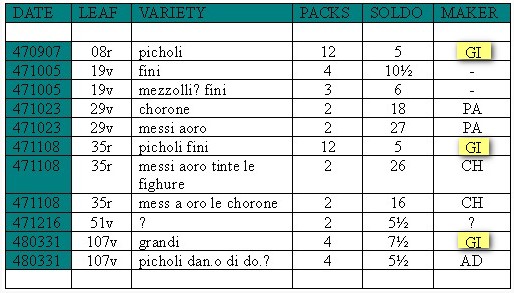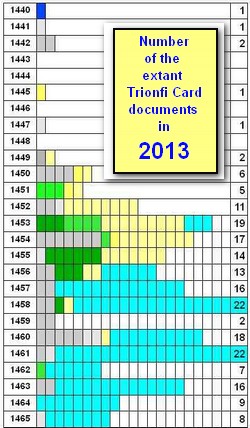"Lo Scheggia" - alias Giovanni di Ser Giovanni (1406-1486)
composed by Lothar Teikemeier, last updated 06.12.2012
|
First recorded activity for Puri family: 1447-09-07 Last recorded activity for Puri family: 1448-03-31  Sale List of the Puri family "GI" stands for Giovanni di Ser Giovanni alias "Lo Scheggia" |
|
Sources
Sources are mainly taken from Franco Pratesi's new article series written from November 2011 till now, published here at Trionfi.com. A "second series" is presented here: Franco Pratesi: 2012/2013| SOURCE 1: Puri family sells decks |
|
Quote from Franco Pratesi: "1447-1449 - NAIBI ON SALE", 27.01.2012 |
An extraordinary cardmakerSeveral names of cardmakers and painters of playing cards who were active in Florence in about those years can be found here and there, but in Richordançe A we find one, who may be more interesting than all the remaining ones: Giovanni da San Giovanni. San Giovanni Valdarno is the present name of a country town that near the end of the 13th century had been built by the Florentines, with the name of Castel San Giovanni, as a fortified settlement in front of Arezzo (not to forget that San Giovanni Battista is still considered as the patron of Florence). |
| SOURCE 2: Franco Pratesi's new article |
Franco Pratesi: AROUND 1450 – LO SCHEGGIA'S MANY-SIDED PRODUCTION, 03.01.2013
|
Quote from Franco Pratesi: "1447-1449 - NAIBI ON SALE", 27.01.2012 |
An extraordinary cardmakerSeveral names of cardmakers and painters of playing cards who were active in Florence in about those years can be found here and there, but in Richordançe A we find one, who may be more interesting than all the remaining ones: Giovanni da San Giovanni. San Giovanni Valdarno is the present name of a country town that near the end of the 13th century had been built by the Florentines, with the name of Castel San Giovanni, as a fortified settlement in front of Arezzo (not to forget that San Giovanni Battista is still considered as the patron of Florence). |
| SOURCE 3: My Own Observations |
When Franco Pratesi detected Lo Scheggia as one of the playing card producers a series of detections was made, mixed with the result of earlier researches and suspicions. It's an older theory of mine, that the socalled Charles VI Tarot (one of the most famous of the old Tarocchi packs, which some time was taken as a deck made by Gringonneur in the year 1392 for the French King Charles VI; this explains its name) would have been made
|
Repeated Note: When Ross Caldwell and me in 2003 started to collect Trionfi notes between 1442-1463, we had about 27/28 entries (which I nowadays would count as 31). The major part were the documents of Ferrara, which were collected by Gherardo Ortalli and Adriano Franceschini in the "Prince and the Playing Cards" (1996), after the base laying works of Michael Dummett and Stuart Kaplan around 1980. This collection included 2 notes about Trionfi cards in Florence, found by Franco Pratesi in his earlier work (allowances of the Trionfi game in 1450 and 1463). A graphical representation of this time (with 27 entries) shows the dominance of Ferrarese documents (in black) with a few notes only from other locations (in red; see picture to the right) In the period 2004 till October 2011 it was possible to add 4 further notes (Siena 1452, Padova 1455, Ancona c. 1460 and Valerio Marcello c. 1460), mainly thanks to information given by Thierry Depaulis. Franco Pratesi started his new article series in November 2011. Since then the list has gotten 67 new documents till September 2012 (65 of them found by Franco Pratesi, one, now the oldest of September 1440, by Thierry Depaulis, and another one by Veber Gulinelli, who controlled the earlier work of Franceschini and found an overlooked document) and nearly all are related to Florence or its surrounding. A small book (118 pages) was published around Christmas 2012, Franco Pratesi: "Playing Card Trade in 15th Century Florence" as IPCS Paper No. 7 (ISSN 0305-2133). It contains some of the articles, which before had appeared at this website, those, which treat the early time of 15th century. Thierry Depaulis commented in his foreword: "This book is a landmark in the history of early playing cards in Italy". Well, maybe not the book, but the research is clearly a landmark in various interests. For the collection of early Trionfi notes it somehow means, that we have within the year 2012 about 200 % more data for the period 1440-1462 than mankind had collected in the 200 years before. Added later: In August 2013 the new report of Arnold und Doris Esch: "Aus der Frühgeschichte der Spielkarte. Der Import von carte da giocare und trionfi nach Rom." in Gutenberg Jahrbuch 2013, 88. Jahrgang, p. 41-53, arrived in our redaction. It contains 106 new references to Trionfi decks, which all were found in the customs registers of the city Rome for the period 1453-1465. With this the number of all earlier Trionfi cards records has been doubled and should have reached then c. 210 (from which a few are only considered to be "Trionfi card notes" and don't contain the word "Trionfi" or something similar). *********** I'd started to sort the new Trionfi card documents overview in October 2012. Articles will be possibly changed according improvements in research. |
|


